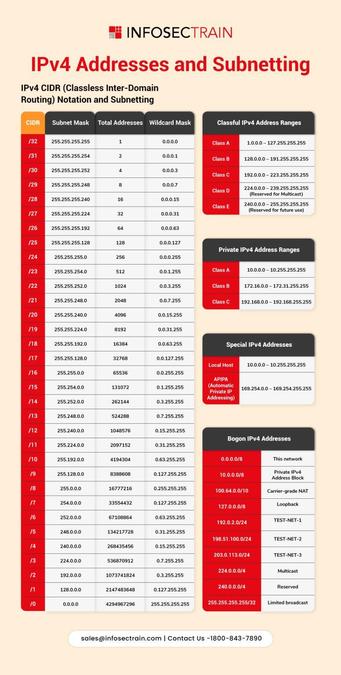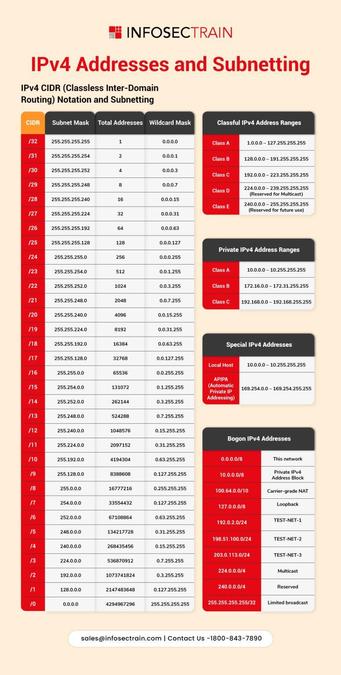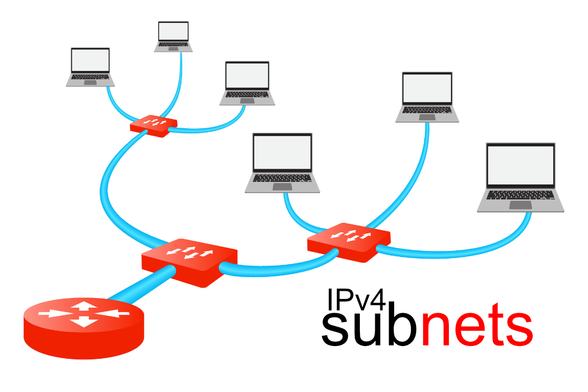Simple Subnet Calculator
Just in case you are also bored to calculate on paper...
#automate #python #subnetting
#Subnetting
IPv4 Addresses & Subnetting: Your Ultimate Guide
Join CISSP training - https://infosectrain.com/courses/cissp-certification-training/
#IPv4 #Networking #Subnetting #CIDR #PrivateIP #DataNetworking
The most relevant IT certification content I ever studied was Cisco CCENT.
Sadly, Cisco has since abandoned that training. But I will continue to place it #1 in what I'd like a tech starting in IT to know. Learn that stuff and you're golden with me; It proves to me you can learn and have the wherewithal to succeed in IT.
#CCENT #IPAddressing #Subnetting #Routing
Ever wondered how devices seamlessly communicate across the digital world?
Learn about IPv4 vs. IPv6, the magic of subnet masks, and how CIDR notation keeps networks organized and optimized.
Read the blog post here: https://woodruff.dev/decoding-ip-addressing-and-subnetting-the-backbone-of-networking/
IPv4 subnet/CIDR table from OccupytheWeb on Twitter: “Network Basics for Hackers: Subnetting, Subnet Masks and CIDR Notation …”
I wrote about programs and scripts doing IPv4 subnet calculation, but sometimes it is easier to have a table at hand, so here is the one I found at [Wayback/Archive] OccupytheWeb on Twitter: “Network Basics for Hackers: Subnetting, Subnet Masks and CIDR Notation #networks #networkbasics #subnetting #infosec #networks4hackers #cyberwarrior #cyberwarrior #networkbasics #networkbasics subnet”
Notes:
- it is by far original, as a quick image search revealed lots of other sources, for instance the 2011 post [Wayback/Archive] Subnet Mask Quick Reference | Academic PCs Blog
- there is a much better table below adapted from Classless Inter-Domain Routing: IPv4 CIDR blocks – Wikipedia
Some earlier related posts:
- Bitcricket IP Subnet Calculator
- Getting your local IPv4 addresses, netmasks and CIDRs
- Getting the primary IP address (plain and CIDR) on Linux and OS X, then nmap scan on the associated subnet
And another example where the same table was used: [Wayback/Archive] tcpip – How to understand the “A subnet Example”? – Server Fault.
Since this one from Classless Inter-Domain Routing: IPv4 CIDR blocks – Wikipedia is much better, I copied it in full then colourised it using the above scheme and added the mask octet and binary mask columns, then added the “(max hosts)” to the “Decimal” columns:
IPv4 CIDR blocks
Address
formatDifference
to last addressMaskMask
octetBinary mask
in octetAddressesRelative
to class
A, B, CRestrictions
on a, b, c and d
(0..255 unless noted)Typical useDecimal
(max hosts)2na.b.c.d/32+0.0.0.0255.255.255.2554111111111201⁄256 CHost routea.b.c.d/31+0.0.0.1255.255.255.2544111111102211⁄128 Cd = 0 … (2n) … 254Point-to-point links (RFC 3021)a.b.c.d/30+0.0.0.3255.255.255.2524111111004221⁄64 Cd = 0 … (4n) … 252Point-to-point links (glue network)a.b.c.d/29+0.0.0.7255.255.255.2484111110008231⁄32 Cd = 0 … (8n) … 248Smallest multi-host networka.b.c.d/28+0.0.0.15255.255.255.24041111000016241⁄16 Cd = 0 … (16n) … 240Small LANa.b.c.d/27+0.0.0.31255.255.255.2244111000003225⅛ Cd = 0 … (32n) … 224a.b.c.d/26+0.0.0.63255.255.255.1924110000006426¼ Cd = 0, 64, 128, 192a.b.c.d/25+0.0.0.127255.255.255.12841000000012827½ Cd = 0, 128Large LANa.b.c.0/24+0.0.0.255255.255.255.0311111111256281 Ca.b.c.0/23+0.0.1.255255.255.254.0311111110512292 Cc = 0 … (2n) … 254a.b.c.0/22+0.0.3.255255.255.252.03111111001,0242104 Cc = 0 … (4n) … 252Small businessa.b.c.0/21+0.0.7.255255.255.248.03111110002,0482118 Cc = 0 … (8n) … 248Small ISP/ large businessa.b.c.0/20+0.0.15.255255.255.240.03111100004,09621216 Cc = 0 … (16n) … 240a.b.c.0/19+0.0.31.255255.255.224.03111000008,19221332 Cc = 0 … (32n) … 224ISP/ large businessa.b.c.0/18+0.0.63.255255.255.192.031100000016,38421464 Cc = 0, 64, 128, 192a.b.c.0/17+0.0.127.255255.255.128.031000000032,768215128 Cc = 0, 128a.b.0.0/16+0.0.255.255255.255.0.021111111165,536216256 C = Ba.b.0.0/15+0.1.255.255255.254.0.0211111110131,0722172 Bb = 0 … (2n) … 254a.b.0.0/14+0.3.255.255255.252.0.0211111100262,1442184 Bb = 0 … (4n) … 252a.b.0.0/13+0.7.255.255255.248.0.0211111000524,2882198 Bb = 0 … (8n) … 248a.b.0.0/12+0.15.255.255255.240.0.02111100001,048,57622016 Bb = 0 … (16n) … 240a.b.0.0/11+0.31.255.255255.224.0.02111000002,097,15222132 Bb = 0 … (32n) … 224a.b.0.0/10+0.63.255.255255.192.0.02110000004,194,30422264 Bb = 0, 64, 128, 192a.b.0.0/9+0.127.255.255255.128.0.02100000008,388,608223128 Bb = 0, 128a.0.0.0/8+0.255.255.255255.0.0.011111111116,777,216224256 B = ALargest IANA block allocationa.0.0.0/7+1.255.255.255254.0.0.011111111033,554,4322252 Aa = 0 … (2n) … 254a.0.0.0/6+3.255.255.255252.0.0.011111110067,108,8642264 Aa = 0 … (4n) … 252a.0.0.0/5+7.255.255.255248.0.0.0111111000134,217,7282278 Aa = 0 … (8n) … 248a.0.0.0/4+15.255.255.255240.0.0.0111110000268,435,45622816 Aa = 0 … (16n) … 240a.0.0.0/3+31.255.255.255224.0.0.0111100000536,870,91222932 Aa = 0 … (32n) … 224a.0.0.0/2+63.255.255.255192.0.0.01110000001,073,741,82423064 Aa = 0, 64, 128, 192a.0.0.0/1+127.255.255.255128.0.0.01100000002,147,483,648231128 Aa = 0, 1280.0.0.0/0+255.255.255.2550.0.0.00000000004,294,967,296232256 AEntire IPv4 Internet, default route.
If you want to modify the table even further, please fork https://gist.github.com/jpluimers/d2665ef16ed20ec9b8266bf154c56830
For now it is hosted as HTML page at https://gist.githack.com/jpluimers/d2665ef16ed20ec9b8266bf154c56830/raw/27cd4c0583771198c65e68f21ee9968c1af64827/IPv4-CIDR-blocks.html
I posted a bitmap of it at [Wayback/Archive] Jeroen Wiert Pluimers on Twitter: “@three_cube For now the HTML is served at …”
–jeroen
This file contains bidirectional Unicode text that may be interpreted or compiled differently than what appears below. To review, open the file in an editor that reveals hidden Unicode characters.
Learn more about bidirectional Unicode characters
<html xmlns="http://www.w3.org/1999/xhtml" lang="en" class="wf-inactive"><head profile="http://gmpg.org/xfn/11"><body><h1><span id="IPv4_CIDR_blocks" class="mw-headline">IPv4 CIDR blocks</span></h1><table class="wikitable" rules="all"><tbody><tr><th rowspan="2">Address<br>format</th><th rowspan="2">Difference<br>to last address</th><th rowspan="2">Mask</th><th rowspan="2">Mask<br>octet</th><th rowspan="2">Binary mask<br>in octet</th><th colspan="2">Addresses</th><th rowspan="2">Relative<br>to class<br>A, B, C</th><th rowspan="2">Restrictions<br>on <i>a</i>, <i>b</i>, <i>c</i> and <i>d</i><br><small>(0..255 unless noted)</small></th><th rowspan="2">Typical use</th></tr><tr><th>Decimal<br>(max hosts)</th><th bgcolor="lightgreen">2<sup><i>n</i></sup></th></tr><tr bgcolor="lightyellow"><td><i><span class="ipaddr">a.b.c.d/32</span></i></td><td>+<i><span class="ipaddr">0.0.0.0</span></i></td><td><i><span class="ipaddr">255.255.255.<span style="color:red;">255</span></span></i></td><td>4</td><td><span style="color:#ff0000;">11111111</span></td><td>1</td><td>2<sup>0</sup></td><td><span class="frac" role="math"><span class="num">1</span>⁄<span class="den">256</span></span> C</td><td></td><td>Host route</td></tr><tr><td><i><span class="ipaddr">a.b.c.d/31</span></i></td><td>+<i><span class="ipaddr">0.0.0.1</span></i></td><td><i><span class="ipaddr">255.255.255.<span style="color:red;">254</span></span></i></td><td>4</td><td><span style="color:red;">11111110</span></td><td>2</td><td bgcolor="lightgreen">2<sup>1</sup></td><td><span class="frac" role="math"><span class="num">1</span>⁄<span class="den">128</span></span> C</td><td><i>d</i> = 0 … (2<i>n</i>) … 254</td><td>Point-to-point links (<a class="mw-redirect" title="RFC (identifier)" href="https://en.wikipedia.org/wiki/RFC_(identifier)">RFC</a> <a class="external text" href="https://datatracker.ietf.org/doc/html/rfc3021" rel="nofollow">3021</a>)</td></tr><tr><td><i><span class="ipaddr">a.b.c.d/30</span></i></td><td>+<i><span class="ipaddr">0.0.0.3</span></i></td><td><i><span class="ipaddr">255.255.255.<span style="color:red;">252</span></span></i></td><td>4</td><td><span style="color:red;">11111100</span></td><td>4</td><td bgcolor="lightgreen">2<sup>2</sup></td><td><span class="frac" role="math"><span class="num">1</span>⁄<span class="den">64</span></span> C</td><td><i>d</i> = 0 … (4<i>n</i>) … 252</td><td><span class="nowrap">Point-to-point links (glue network)</span></td></tr><tr><td><i><span class="ipaddr">a.b.c.d/29</span></i></td><td>+<i><span class="ipaddr">0.0.0.7</span></i></td><td><i><span class="ipaddr">255.255.255.<span style="color:red;">248</span></span></i></td><td>4</td><td><span style="color:red;">11111000</span></td><td>8</td><td bgcolor="lightgreen">2<sup>3</sup></td><td><span class="frac" role="math"><span class="num">1</span>⁄<span class="den">32</span></span> C</td><td><i>d</i> = 0 … (8<i>n</i>) … 248</td><td>Smallest multi-host network</td></tr><tr><td><i><span class="ipaddr">a.b.c.d/28</span></i></td><td>+<i><span class="ipaddr">0.0.0.15</span></i></td><td><i><span class="ipaddr">255.255.255.<span style="color:red;">240</span></span></i></td><td>4</td><td><span style="color:red;">11110000</span></td><td>16</td><td bgcolor="lightgreen">2<sup>4</sup></td><td><span class="frac" role="math"><span class="num">1</span>⁄<span class="den">16</span></span> C</td><td><i>d</i> = 0 … (16<i>n</i>) … 240</td><td rowspan="3">Small <a class="mw-redirect" title="LAN" href="https://en.wikipedia.org/wiki/LAN">LAN</a></td></tr><tr><td><i><span class="ipaddr">a.b.c.d/27</span></i></td><td>+<i><span class="ipaddr">0.0.0.31</span></i></td><td><i><span class="ipaddr">255.255.255.<span style="color:red;">224</span></span></i></td><td>4</td><td><span style="color:red;">11100000</span></td><td>32</td><td bgcolor="lightgreen">2<sup>5</sup></td><td>⅛ C</td><td><i>d</i> = 0 … (32<i>n</i>) … 224</td></tr><tr><td><i><span class="ipaddr">a.b.c.d/26</span></i></td><td>+<i><span class="ipaddr">0.0.0.63</span></i></td><td><i><span class="ipaddr">255.255.255.<span style="color:red;">192</span></span></i></td><td>4</td><td><span style="color:red;">11000000</span></td><td>64</td><td bgcolor="lightgreen">2<sup>6</sup></td><td>¼ C</td><td><i>d</i> = 0, 64, 128, 192</td></tr><tr><td><i><span class="ipaddr">a.b.c.d/25</span></i></td><td>+<i><span class="ipaddr">0.0.0.127</span></i></td><td><i><span class="ipaddr">255.255.255.<span style="color:red;">128</span></span></i></td><td>4</td><td><span style="color:red;">10000000</span></td><td>128</td><td bgcolor="lightgreen">2<sup>7</sup></td><td>½ C</td><td><i>d</i> = 0, 128</td><td rowspan="2">Large <a class="mw-redirect" title="LAN" href="https://en.wikipedia.org/wiki/LAN">LAN</a></td></tr><tr bgcolor="lightyellow"><td><i><span class="ipaddr">a.b.c.0/24</span></i></td><td>+<i><span class="ipaddr">0.0.0.255</span></i></td><td><i><span class="ipaddr">255.255.<span style="color:red;">255</span>.0</span></i></td><td>3</td><td><span style="color:red;">11111111</span></td><td>256</td><td>2<sup>8</sup></td><td>1 C</td><td></td></tr><tr><td><i><span class="ipaddr">a.b.c.0/23</span></i></td><td>+<i><span class="ipaddr">0.0.1.255</span></i></td><td><i><span class="ipaddr">255.255.<span style="color:red;">254</span>.0</span></i></td><td>3</td><td><span style="color:red;">11111110</span></td><td>512</td><td bgcolor="lightgreen">2<sup>9</sup></td><td>2 C</td><td><i>c</i> = 0 … (2<i>n</i>) … 254</td><td></td></tr><tr><td><i><span class="ipaddr">a.b.c.0/22</span></i></td><td>+<i><span class="ipaddr">0.0.3.255</span></i></td><td><i><span class="ipaddr">255.255.<span style="color:red;">252</span>.0</span></i></td><td>3</td><td><span style="color:red;">11111100</span></td><td>1,024</td><td bgcolor="lightgreen">2<sup>10</sup></td><td>4 C</td><td><i>c</i> = 0 … (4<i>n</i>) … 252</td><td>Small business</td></tr><tr><td><i><span class="ipaddr">a.b.c.0/21</span></i></td><td>+<i><span class="ipaddr">0.0.7.255</span></i></td><td><i><span class="ipaddr">255.255.<span style="color:red;">248</span>.0</span></i></td><td>3</td><td><span style="color:red;">11111000</span></td><td>2,048</td><td bgcolor="lightgreen">2<sup>11</sup></td><td>8 C</td><td><i>c</i> = 0 … (8<i>n</i>) … 248</td><td rowspan="2">Small <a class="mw-redirect" title="ISP" href="https://en.wikipedia.org/wiki/ISP">ISP</a>/ large business</td></tr><tr><td><i><span class="ipaddr">a.b.c.0/20</span></i></td><td>+<i><span class="ipaddr">0.0.15.255</span></i></td><td><i><span class="ipaddr">255.255.<span style="color:red;">240</span>.0</span></i></td><td>3</td><td><span style="color:red;">11110000</span></td><td>4,096</td><td bgcolor="lightgreen">2<sup>12</sup></td><td>16 C</td><td><i>c</i> = 0 … (16<i>n</i>) … 240</td></tr><tr><td><i><span class="ipaddr">a.b.c.0/19</span></i></td><td>+<i><span class="ipaddr">0.0.31.255</span></i></td><td><i><span class="ipaddr">255.255.<span style="color:red;">224</span>.0</span></i></td><td>3</td><td><span style="color:red;">11100000</span></td><td>8,192</td><td bgcolor="lightgreen">2<sup>13</sup></td><td>32 C</td><td><i>c</i> = 0 … (32<i>n</i>) … 224</td><td rowspan="3"><a class="mw-redirect" title="ISP" href="https://en.wikipedia.org/wiki/ISP">ISP</a>/ large business</td></tr><tr><td><i><span class="ipaddr">a.b.c.0/18</span></i></td><td>+<i><span class="ipaddr">0.0.63.255</span></i></td><td><i><span class="ipaddr">255.255.<span style="color:red;">192</span>.0</span></i></td><td>3</td><td><span style="color:red;">11000000</span></td><td>16,384</td><td bgcolor="lightgreen">2<sup>14</sup></td><td>64 C</td><td><i>c</i> = 0, 64, 128, 192</td></tr><tr><td><i><span class="ipaddr">a.b.c.0/17</span></i></td><td>+<i><span class="ipaddr">0.0.127.255</span></i></td><td><i><span class="ipaddr">255.255.<span style="color:red;">128</span>.0</span></i></td><td>3</td><td><span style="color:red;">10000000</span></td><td>32,768</td><td bgcolor="lightgreen">2<sup>15</sup></td><td>128 C</td><td><i>c</i> = 0, 128</td></tr><tr bgcolor="lightyellow"><td><i><span class="ipaddr">a.b.0.0/16</span></i></td><td>+<i><span class="ipaddr">0.0.255.255</span></i></td><td><i><span class="ipaddr">255.<span style="color:red;">255</span>.0.0</span></i></td><td>2</td><td><span style="color:red;">11111111</span></td><td>65,536</td><td>2<sup>16</sup></td><td>256 C = B</td><td></td><td></td></tr><tr><td><i><span class="ipaddr">a.b.0.0/15</span></i></td><td>+<i><span class="ipaddr">0.1.255.255</span></i></td><td><i><span class="ipaddr">255.<span style="color:red;">254</span>.0.0</span></i></td><td>2</td><td><span style="color:red;">11111110</span></td><td>131,072</td><td bgcolor="lightgreen">2<sup>17</sup></td><td>2 B</td><td><i>b</i> = 0 … (2<i>n</i>) … 254</td><td></td></tr><tr><td><i><span class="ipaddr">a.b.0.0/14</span></i></td><td>+<i><span class="ipaddr">0.3.255.255</span></i></td><td><i><span class="ipaddr">255.<span style="color:red;">252</span>.0.0</span></i></td><td>2</td><td><span style="color:red;">11111100</span></td><td>262,144</td><td bgcolor="lightgreen">2<sup>18</sup></td><td>4 B</td><td><i>b</i> = 0 … (4<i>n</i>) … 252</td><td></td></tr><tr><td><i><span class="ipaddr">a.b.0.0/13</span></i></td><td>+<i><span class="ipaddr">0.7.255.255</span></i></td><td><i><span class="ipaddr">255.<span style="color:red;">248</span>.0.0</span></i></td><td>2</td><td><span style="color:red;">11111000</span></td><td>524,288</td><td bgcolor="lightgreen">2<sup>19</sup></td><td>8 B</td><td><i>b</i> = 0 … (8<i>n</i>) … 248</td><td></td></tr><tr><td><i><span class="ipaddr">a.b.0.0/12</span></i></td><td>+<i><span class="ipaddr">0.15.255.255</span></i></td><td><i><span class="ipaddr">255.<span style="color:red;">240</span>.0.0</span></i></td><td>2</td><td><span style="color:red;">11110000</span></td><td>1,048,576</td><td bgcolor="lightgreen">2<sup>20</sup></td><td>16 B</td><td><i>b</i> = 0 … (16<i>n</i>) … 240</td><td></td></tr><tr><td><i><span class="ipaddr">a.b.0.0/11</span></i></td><td>+<i><span class="ipaddr">0.31.255.255</span></i></td><td><i><span class="ipaddr">255.<span style="color:red;">224</span>.0.0</span></i></td><td>2</td><td><span style="color:red;">11100000</span></td><td>2,097,152</td><td bgcolor="lightgreen">2<sup>21</sup></td><td>32 B</td><td><i>b</i> = 0 … (32<i>n</i>) … 224</td><td></td></tr><tr><td><i><span class="ipaddr">a.b.0.0/10</span></i></td><td>+<i><span class="ipaddr">0.63.255.255</span></i></td><td><i><span class="ipaddr">255.<span style="color:red;">192</span>.0.0</span></i></td><td>2</td><td><span style="color:red;">11000000</span></td><td>4,194,304</td><td bgcolor="lightgreen">2<sup>22</sup></td><td>64 B</td><td><i>b</i> = 0, 64, 128, 192</td><td></td></tr><tr><td><i><span class="ipaddr">a.b.0.0/9</span></i></td><td>+<i><span class="ipaddr">0.127.255.255</span></i></td><td><i><span class="ipaddr">255.<span style="color:red;">128</span>.0.0</span></i></td><td>2</td><td><span style="color:red;">10000000</span></td><td>8,388,608</td><td bgcolor="lightgreen">2<sup>23</sup></td><td>128 B</td><td><i>b</i> = 0, 128</td><td></td></tr><tr bgcolor="lightyellow"><td><i><span class="ipaddr">a.0.0.0/8</span></i></td><td>+<i><span class="ipaddr">0.255.255.255</span></i></td><td><i><span class="ipaddr"><span style="color:red;">255</span>.0.0.0</span></i></td><td>1</td><td><span style="color:red;">11111111</span></td><td>16,777,216</td><td>2<sup>24</sup></td><td>256 B = A</td><td></td><td>Largest <a title="Internet Assigned Numbers Authority" href="https://en.wikipedia.org/wiki/Internet_Assigned_Numbers_Authority">IANA</a> block allocation</td></tr><tr><td><i><span class="ipaddr">a.0.0.0/7</span></i></td><td>+<i><span class="ipaddr">1.255.255.255</span></i></td><td><i><span class="ipaddr"><span style="color:red;">254</span>.0.0.0</span></i></td><td>1</td><td><span style="color:red;">11111110</span></td><td>33,554,432</td><td bgcolor="lightgreen">2<sup>25</sup></td><td>2 A</td><td><i>a</i> = 0 … (2<i>n</i>) … 254</td><td></td></tr><tr><td><i><span class="ipaddr">a.0.0.0/6</span></i></td><td>+<i><span class="ipaddr">3.255.255.255</span></i></td><td><i><span class="ipaddr"><span style="color:red;">252</span>.0.0.0</span></i></td><td>1</td><td><span style="color:red;">11111100</span></td><td>67,108,864</td><td bgcolor="lightgreen">2<sup>26</sup></td><td>4 A</td><td><i>a</i> = 0 … (4<i>n</i>) … 252</td><td></td></tr><tr><td><i><span class="ipaddr">a.0.0.0/5</span></i></td><td>+<i><span class="ipaddr">7.255.255.255</span></i></td><td><i><span class="ipaddr"><span style="color:red;">248</span>.0.0.0</span></i></td><td>1</td><td><span style="color:red;">11111000</span></td><td>134,217,728</td><td bgcolor="lightgreen">2<sup>27</sup></td><td>8 A</td><td><i>a</i> = 0 … (8<i>n</i>) … 248</td><td></td></tr><tr><td><i><span class="ipaddr">a.0.0.0/4</span></i></td><td>+<i><span class="ipaddr">15.255.255.255</span></i></td><td><i><span class="ipaddr"><span style="color:red;">240</span>.0.0.0</span></i></td><td>1</td><td><span style="color:red;">11110000</span></td><td>268,435,456</td><td bgcolor="lightgreen">2<sup>28</sup></td><td>16 A</td><td><i>a</i> = 0 … (16<i>n</i>) … 240</td><td></td></tr><tr><td><i><span class="ipaddr">a.0.0.0/3</span></i></td><td>+<i><span class="ipaddr">31.255.255.255</span></i></td><td><i><span class="ipaddr"><span style="color:red;">224</span>.0.0.0</span></i></td><td>1</td><td><span style="color:red;">11100000</span></td><td>536,870,912</td><td bgcolor="lightgreen">2<sup>29</sup></td><td>32 A</td><td><i>a</i> = 0 … (32<i>n</i>) … 224</td><td></td></tr><tr><td><i><span class="ipaddr">a.0.0.0/2</span></i></td><td>+<i><span class="ipaddr">63.255.255.255</span></i></td><td><i><span class="ipaddr"><span style="color:red;">192</span>.0.0.0</span></i></td><td>1</td><td><span style="color:red;">11000000</span></td><td>1,073,741,824</td><td bgcolor="lightgreen">2<sup>30</sup></td><td>64 A</td><td><i>a</i> = 0, 64, 128, 192</td><td></td></tr><tr><td><i><span class="ipaddr">a.0.0.0/1</span></i></td><td>+<i><span class="ipaddr">127.255.255.255</span></i></td><td><i><span class="ipaddr"><span style="color:red;">128</span>.0.0.0</span></i></td><td>1</td><td><span style="color:red;">10000000</span></td><td>2,147,483,648</td><td bgcolor="lightgreen">2<sup>31</sup></td><td>128 A</td><td><i>a</i> = 0, 128</td><td></td></tr><tr bgcolor="lightyellow"><td><i><span class="ipaddr">0.0.0.0/0</span></i></td><td>+<i><span class="ipaddr">255.255.255.255</span></i></td><td><i><span class="ipaddr">0.0.0.0</span></i></td><td>0</td><td>00000000</td><td>4,294,967,296</td><td>2<sup>32</sup></td><td>256 A</td><td></td><td>Entire IPv4 Internet, <a title="Default route" href="https://en.wikipedia.org/wiki/Default_route">default route</a>.</td></tr></tbody></table></body></html> view raw
IPv4-CIDR-blocks.html
hosted with ❤ by GitHub
#cyberwarrior #infosec #networkbasics #networks #networks4hackers #subnetting
IPv4 Addresses & Subnetting: Your Ultimate Guide 🌐
💬 Got questions or tips on subnetting? Let’s chat in the comments below!
#IPv4 #Networking #Subnetting #CIDR #PrivateIP #DataNetworking #TechTips #CyberSecurity #NetworkingBasics #IPAddressing #infosectraain #learntorise
Lab 6.1 - Calculating Subnets
https://zpr.io/purEnNBBzkek
Learn how to calculate subnet addresses, network, and broadcast addresses, and identify the subnet an IP belongs to using an IP address and subnet mask. Master subnetting with simple steps and clear examples! #Networking #Subnetting #IPv4 #Mikrotik
Gibt's hier jemanden der #Subnetting gut erklären kann?
Ich habe das Prinzip verstanden, aber wenn ich vor einer Aufgabe sitze, weiß ich oft nicht, wo ich anfangen soll.
#IT #Fachinformatiker #Netzwerk #network
*yawn stretch* moin!
While climbing out of bed, it occurred to me - I should be able to reuse the "same" #IPv4 address in different subnets;
10.1.2.3/8
shouldn't conflict with
10.1.2.3/16
because they're in different subnets, right?
Am I thinking this right, or should I get my coffee 1st?
edit: Of course, they couldn't ping each other (despite #subnetting), and even a #router in between wouldn't know which host to ping - both hosts should be able to ping the router, though.
#subnetting - I just left a lesson feeling like the most stupid person on earth. Do you have a pointer towards an ipv4 and ipv6 online course fot dummies?
Yes, #IPv4 is the legacy Internet protocol, but unfortunately we're facing a long period of dual-stack networks and #subnetting is still a thing. In his #deepdive Kevin Wallace explained it in a simple way with easy hints to remember. https://youtu.be/vY4cjGpRiIs
Cisco has long since retired the CCENT certification but if I were a hiring manager and a candidate had only that one cert under their belt I'd hire them immediately. That knowledge proves one can learn and move forward in a career. #Subnetting #CCENT #ICND1 #Certification #EntryLevelNetworking #SkillSet
Old subnetting notes I had to dig up and refresh on while studying tonight. Enjoy!
Subnetting:
The representations of IP’s and prefixes (our masks) exist for each range. Whenever we see a /8, /16, or /24, the /number is a prefix, so 10.10.10.1 /24 is an address with a prefix. The classes listed for IPv4 aren't actually too scary when you space out exactly what is going on.
Let’s say we have a 255.255.255.0 mask
Try to look at it this way: Class A is X.Y.Y.Y Y being the hosts by number
If we have a /24 and need to understand how this translates:
255.255.255.0 is the value we end up with because the binary equivalent to 255 is 11111111
If we do this for every portion of our mask we get:
11111111.11111111.11111111.00000000
We end up with /24 because we are counting each set of 1's (11111111 + 11111111 + 11111111 = 24).
All we're essentially doing here when we subnet is counting the bits and looking at a mask.
If you look at it this way then the 2n-2 formula makes a lot more sense and becomes clearer.
What would be a /26 ? 11111111.11111111.11111111.11000000 or 24 +2
We added 2 bits to the sum we had when we converted and if we convert 11000000 again, we get 192 as a number. Then we subtract.
Resources:
https://subnetting.org
https://www.youtube.com/watch?v=ZxAwQB8TZsM



